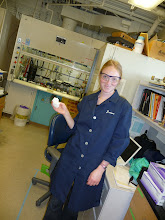
The major ingredient in many acne treatments is benzoyl peroxide (BPO). Did you ever wonder how it works?
BPO is a member of a larger class of compounds called peroxides, which are characterized by an oxygen-oxygen single bond (you may be familiar with hydrogen peroxide, which is the simplest member of this family). A common property among peroxides is a relatively low bond dissociation energy associated with the oxygen-oxygen single bond (51 kcal/mol for hydrogen peroxide). This weak bond easily dissociates to form two radical species, which can undergo subsequent reactions with other chemicals present in the surrounding environment.

The efficacy of BPO stems mainly through its ability to induce breakdown of the outer layer(s) of skin (termed "desquamation" in the medical community). It acts by breaking up the structural proteins (keratins) in the affected area. Once absorbed by the skin, BPO is converted to benzoic acid, presumably via hydrogen abstraction from the keratins.
BPO is a member of a larger class of compounds called peroxides, which are characterized by an oxygen-oxygen single bond (you may be familiar with hydrogen peroxide, which is the simplest member of this family). A common property among peroxides is a relatively low bond dissociation energy associated with the oxygen-oxygen single bond (51 kcal/mol for hydrogen peroxide). This weak bond easily dissociates to form two radical species, which can undergo subsequent reactions with other chemicals present in the surrounding environment.

The efficacy of BPO stems mainly through its ability to induce breakdown of the outer layer(s) of skin (termed "desquamation" in the medical community). It acts by breaking up the structural proteins (keratins) in the affected area. Once absorbed by the skin, BPO is converted to benzoic acid, presumably via hydrogen abstraction from the keratins.





No comments:
Post a Comment